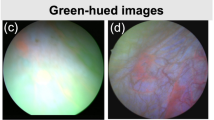Abstract
Background
Glare from surgical instruments and tissue surfaces often occurs during endoscopic procedures and can be disturbing to the operator. The brightness level of the light source can be reduced, but at the expense of overall image clarity, so alternative solutions are needed for removing glare. Digital image-processing methods offer the opportunity to lessen or eliminate glare by reducing the intensity of the affected parts of the image. This study investigated a new automated method for glare reduction that uses two different intensity thresholds as a basis for applying glare reduction processes and it also reduces unpleasant artifacts at the glare region boundaries.
Methods
The new glare-reduction method was compared with a previous method. Three variants of each method, each with different color biases in the glare regions, were applied to a 20-s surgical recording containing substantial amounts of glare. The six versions and the original recording were evaluated subjectively by a group of 10 experienced surgeons using a paired-comparisons method, in which each version was compared for preference with all the other versions.
Results
The new double-threshold intensity-subtraction method scored significantly higher than the previously developed glare-reduction method (p < 0.05). It also scored higher than the original (unprocessed) version, but not significantly. The color bias was important, with combinations of pink and grey performing better than yellow tints.
Conclusions
The findings show the new method to be a significant improvement in automatic glare reduction compared with earlier methods. The method is not computationally demanding, so it can in the future be evaluated clinically in high-definition endoscopic imaging systems and developed further in this environment.






Similar content being viewed by others
References
Mangold T (2012) In: Frey KB, Ross T (eds) Surgical technology for the surgical technologist: a positive care approach, 4th edn. Association of Surgical Technologists, New York
Sheedy JE, Hayes J, Engle (2003) Is all asthenopia the same? J Optom Vis Sci 80:732–739
Stehle T (2006) Removal of specular reflections in endoscopic images. Acta Polytech 46:32–36
Arnold M, Ghosh A, Ameling S, Lacey G (2010) Automatic segmentation and inpainting of specular highlights for endoscopic imaging. EURASIP J Image Video Process. doi:10.1155/2010/814319
Tan P, Lin S, Quan L, Shum H-Y (2003). Highlight removal by illumination-constrained inpainting. In: Proceedings of the 9th IEEE international conference on computer vision, vol 1. Nice, France, pp 164–169
Stoyanov D, Guang Z-Y, Yang (2005) Removing specular reflection components for robotic assisted laparoscopic surgery. In: Proceedings of the IEEE international conference on image processing (ICIP 2005), vol 3. Genoa, Italy, pp 632–635
Jambhorkar SS, Gornale SS, Humbe VT, Manza RR, Kale KV (2006) Uneven background extraction and segmentation of good, normal and bad quality fingerprint images. In: Proceedings of the IEEE international conference on advanced computing and communications, vol 34. Mangalore, India, 20–23 December, pp 222–225
Shi Z-X, Venu G (2004) Historical document image enhancement using background-light-intensity normalization. In: Proceedings of the 17th international conference on pattern recognition, vol 1. Cambridge, UK, pp 473–476
Lange H (2005) Automatic glare removal in reflectance imagery of the uterine cervix. Proc SPIE 5747:2183–2192
Abel EW, Xi W, White PS (2011) Methods for removing glare in digital endoscope images. Surg Endosc 25:3898–3905
Cavanagh P, Anstis M, Macleod A (1987) Equiluminance: spatial and temporal factors and the contribution of blue-sensitive cones. J Opt Soc Am A 4:1428–1438
Brown TC, Peterson GL (2009) An enquiry into the method of paired comparison. U.S. Department of Agriculture, General Technical Reports. RMRS-GTR-216WWW, Fort Collins, CO, USA
Tominaga S (1991) Surface identification using the dichromatic reflection model. IEEE Trans Pattern Anal Mach Intell 13:658–670
Forster CHQ, Tozzi CL (2000) Towards 3D reconstruction of endoscope images using shape from shading. In: Proceedings of the XIII Brazilian symposium on computer graphics and image processing, IEEE Conference Publications, Piscataway, USA, pp 90–96
Disclosures
Eric W. Abel, Yuan Zhuo, Peter D. Ross, and Paul S. White have no conflicts of interest or financial ties to disclose.
Author information
Authors and Affiliations
Corresponding author
Rights and permissions
About this article
Cite this article
Abel, E.W., Zhuo, Y., Ross, P.D. et al. Automatic glare removal in endoscopic imaging. Surg Endosc 28, 584–591 (2014). https://doi.org/10.1007/s00464-013-3209-8
Received:
Accepted:
Published:
Issue Date:
DOI: https://doi.org/10.1007/s00464-013-3209-8




